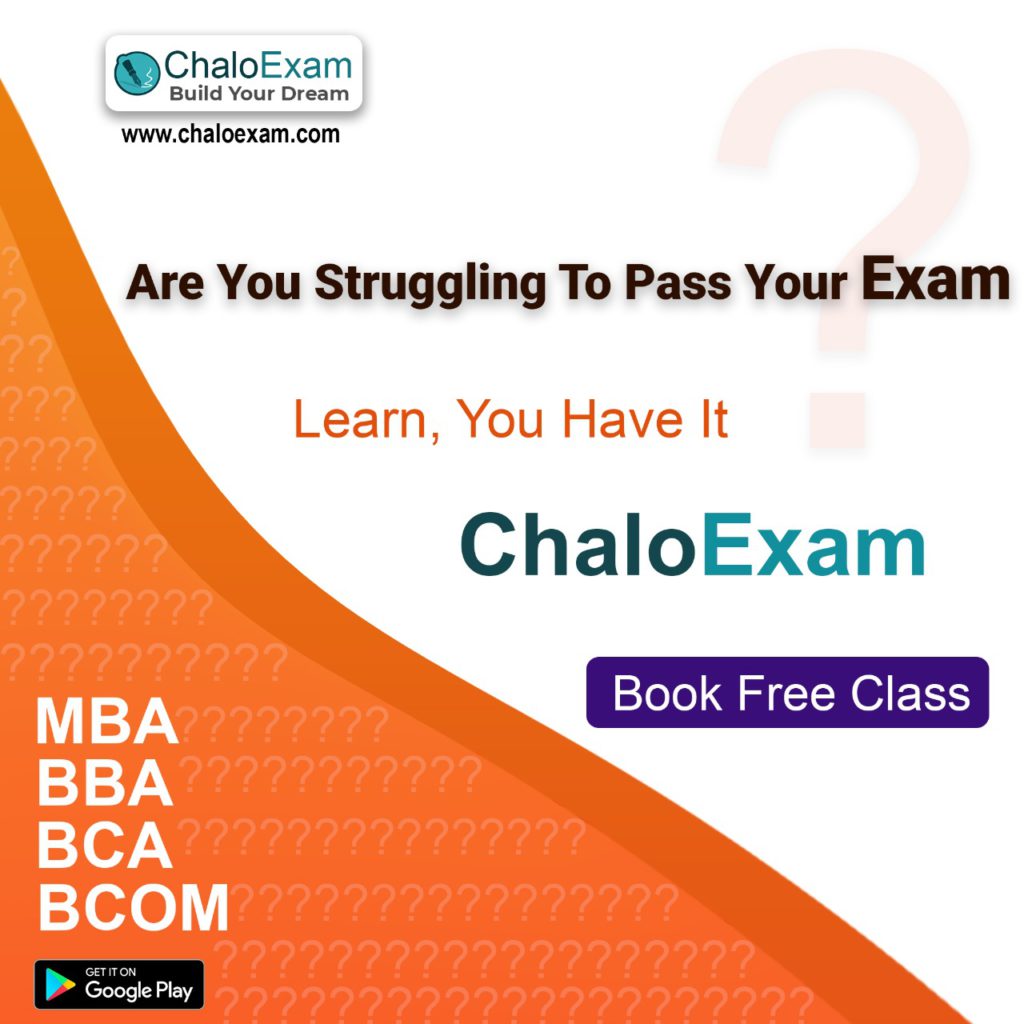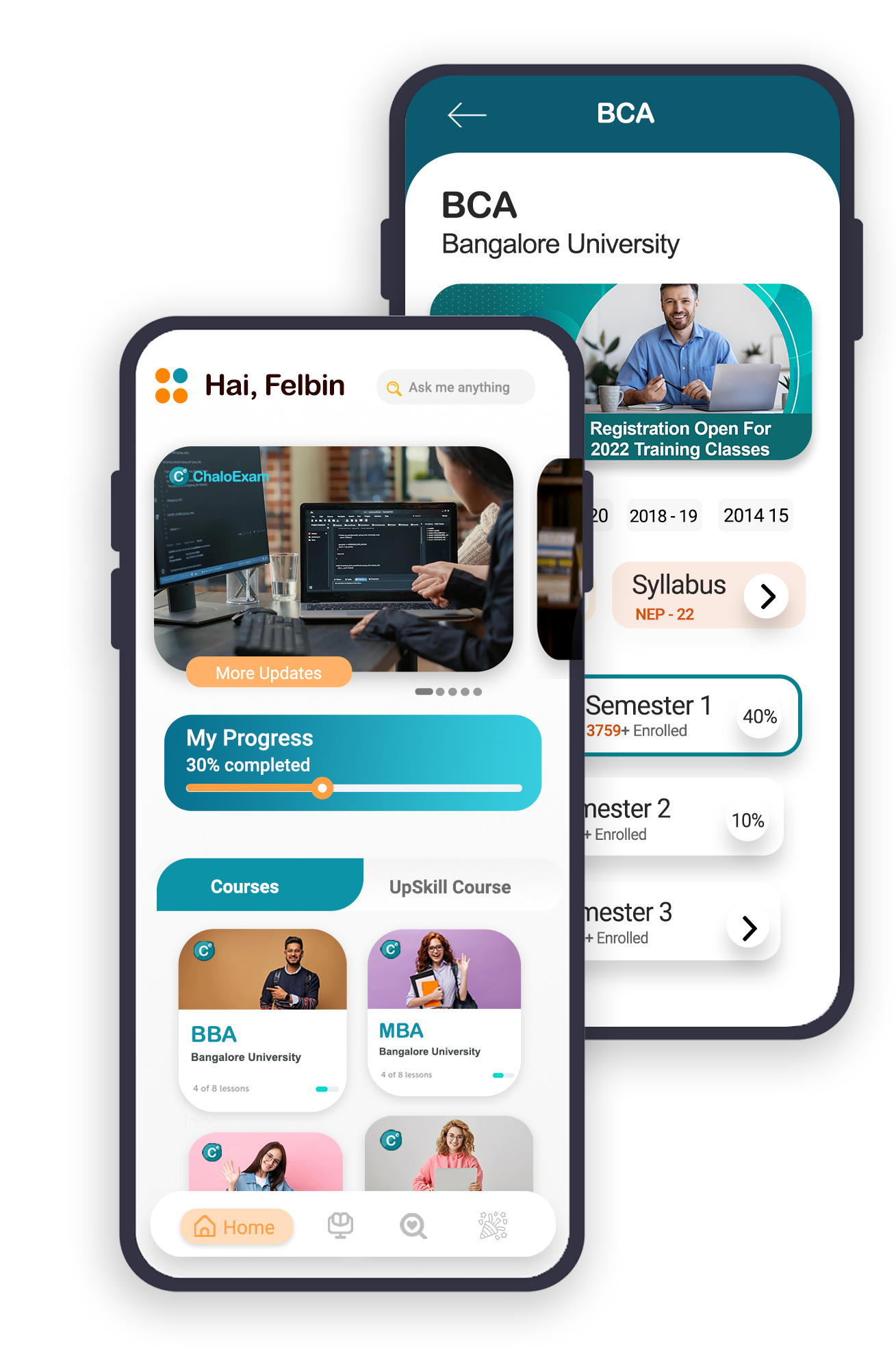Bangalore University 3rd Sem BCOM Study Materials
Download free BCOM 3rd sem module wise notes, latest solved question papers, previous 5 years question paper till 2021, model question papers, easy notes, exam-oriented notes are available on this website chaloexam.com of Bangalore University
Syllabus
3.3 CORPORATE ACCOUNTING
OBJECTIVE
The objective of this subject is to enable the students to have a comprehensive awareness about the provisions of the Company’s Act and Corporate Accounts.
Unit 1: UNDERWRITING OF SHARES 08 Hrs Meaning – Underwriting Commission – Underwriter – functions - Advantages of Underwriting, Types of Underwriting – Marked and Unmarked Applications – Problems (Excluding Journal entries).
Unit 2: PROFIT PRIOR TO INCORPORATION 12 Hrs Meaning – calculation of sales ratio – time ratio – weighted ratio – treatment of capital and revenue expenditure – Ascertainment of pre-incorporation and post-incorporation profits by preparing Profit and Loss Account and Balance Sheet.
Unit 3: VALUATION OF GOODWILL 08 Hrs Meaning – Circumstances of Valuation of Goodwill – Factors influencing the value of Goodwill – Methods of Valuation of Goodwill: Average Profit Method, Super Profit Method, Capitalization of average Profit Method, Capitalization of Super Profit Method, and Annuity Method - Problems.
Unit 4: VALUATION OF SHARES 08 Hrs Meaning – Need for Valuation – Factors Affecting Valuation – Methods of Valuation: Intrinsic Value Method, Yield Method, Earning Capacity Method, Fair Value of shares. Rights Issue and Valuation of Rights Issue - Problems.
Unit 5: COMPANY FINAL ACCOUNTS 20 Hrs Statutory Provisions regarding preparation of Company Final Accounts –Treatment of Special Items – Tax deducted at source – Advance payment of Tax – Provision for Tax – Depreciation – Interest on debentures – Dividends – Rules regarding payment of dividends – Transfer to Reserves – Preparation of Profit and Loss Account and Balance Sheet in vertical form (As per 2011 revised format)
SKILL DEVELOPMENT
- Collect and fill the share application form of a limited Company.
- Collect Prospectus of a company and identify its salient features.
- Collect annual report of a Company and List out its assets and Liabilities. ● Collection of latest final accounts of a company and find out the intrinsic value of shares ● Collect the annual reports of company and calculate the value of goodwill under different methods
BOOKS FOR REFERENCE
- Arulanandam & Raman ; Corporate Accounting –II
- Anil Kumar – Financial Accounting, HPH
- Dr. S.N. Maheswari, Financial Accounting.
- Soundarajan. A & K. Venkataramana, Corporate Accounting, VBH.
- S. P. Jain and K. L. Narang – Corporate Accounting
- S. Bhat- Corporate Accounting.
- S P Iyengar, Advanced Accountancy, Sultan Chand
- R L Gupta, Advanced Accountancy.
- Shukla and Grewal – Financial Accounting.
21
3.4 FINANCIAL MANAGEMENT
OBJECTIVE
The objective is to enable students to understand the basic concepts of Financial Management and the role of Financial Management in decision-making.
Unit 1: INTRODUCTION FINANCIAL MANAGEMENT 10 Hrs Introduction – Meaning of Finance – Business Finance – Finance Function – Aims of Finance Function – Organization structure of Finance Department - Financial Management – Goals of Financial Management – Financial Decisions – Role of a Financial Manager – Financial Planning – Steps in Financial Planning – Principles of Sound Financial Planning – Factors influencing a sound financial plan.
Unit 2: TIME VALUE OF MONEY 12 Hrs Introduction – Meaning& Definition – Need – Future Value (Single Flow – Uneven Flow & Annuity) – Present Value (Single Flow – Uneven Flow & Annuity)– Doubling Period – Concept of Valuation: Valuation of Bonds, Debentures and shares - Simple Problems.
Unit 3: FINANCING DECISION 12 Hrs Introduction – Meaning of Capital Structure – Factors influencing Capital Structure – Optimum Capital Structure – Computation & Analysis of EBIT, EBT, EPS – Leverages. Simple Problems.
Unit 4: INVESTMENT & DIVIDEND DECISION 16 Hrs Investment Decision: Introduction – Meaning and Definition of Capital Budgeting – Features – Significance – Process – Techniques: Payback Period, Accounting Rate of Return, Net Present Value, Internal Rate of Return and profitability index Simple Problems. Dividend Decision: Introduction – Meaning and Definition – Determinants of Dividend Policy – Types of Dividends – Bonus share
Unit 5: WORKING CAPITAL MANAGEMENT 06 Hrs Introduction – Concept of Working Capital – Significance of Adequate Working Capital – Evils of Excess or Inadequate Working Capital – Determinants of Working Capital – Sources of Working Capital.
SKILL DEVELOPMENT
∙ Draw the organization chart of Finance Function of a company.
∙ Evaluate the NPV of an investment made in any one of the capital projects with imaginary figures for 5 years.
∙ Capital structure analysis of companies in different industries
∙ Imaginary figures prepare an estimate of working capital requirements
BOOKS FOR REFERENCE
- S N Maheshwari, Financial Management, Sultan Chand
- Dr. Aswathanarayana.T – Financial Management, VBH
- K. Venkataramana, Financial Management, SHBP.
- G. Sudarshan Reddy, Financial Management, HPH
- Roy – Financial Management, HPH
- Khan and Jain, Financial Management, TMH
- S. Bhat- Financial Management.
- Sharma and Sashi Gupta, Financial Management, Kalyani Publication.
- I M Pandey, Financial Management. Vikas Publication.
- Prasanna Chandra, Financial Management, TMH
- P.K Simha – Financial Management.
- M. Gangadhar Rao & Others , Financial management
- Dr. Alice Mani: Financial Management, SBH.
22
3.5BUSINESS ETHICS
OBJECTIVE
The objective is to provide basic knowledge of business ethics and values and its relevance in modern context.
Unit 1: BUSINESS ETHICS 12 Hrs Introduction – Meaning - Scope – Types of Ethics – Characteristics – Factors influencing Business Ethics – Importance of Business Ethics - Arguments for and against business ethics- Basics of business ethics - Corporate Social Responsibility – Issues of Management – Crisis Management
Unit 2: PERSONAL ETHICS 12 Hrs Introduction – Meaning – Emotional Honesty – Virtue of humility – Promote happiness – karma yoga – proactive – flexibility and purity of mind.
Unit 3: ETHICS IN MANAGEMENT 12 Hrs Introduction – Ethics in HRM – Marketing Ethics – Ethical aspects of Financial Management – Technology Ethics and Professional ethics.
Unit 4: ROLE OF CORPORATE CULTURE IN BUSINESS 12 Hrs Meaning – Functions – Impact of corporate culture – cross cultural issues in ethics
Unit 5: CORPORATE GOVERNANCE 12 Hrs Meaning, scope, composition of BODs, Cadbury Committee, various committees, reports on corporate governance, scope of Corporate Governance, Benefits and Limitations of Corporate Governance with living examples.
SKILL DEVELOPMENT
∙ State the arguments for and against business ethics
∙ Make a list of unethical aspects of finance in any organization
∙ List out ethical problems faced by managers
∙ List out issues involved in Corporate Governance.
∙ List out unethical aspects of Advertising
BOOKS FOR REFERENCE
- Murthy CSV: Business Ethics and Corporate Governance, HPH
- Bholananth Dutta, S.K. Podder – Corporation Governance, VBH.
- Dr. K. Nirmala, Karunakara Readdy : Business Ethics and Corporate Governance, HPH 4. H.R.Machiraju: Corporate Governance
- K. Venkataramana, Corporate Governance, SHBP.
- N.M.Khandelwal : Indian Ethos and Values for Managers
- S Prabhakaran; Business ethics and Corporate Governance
- C.V. Baxi: Corporate Governance
- R. R. Gaur, R. Sanghal, G. P. Bagaria; Human Values and Professional ethics 10. B O B Tricker, Corporate Governance; Principles , Policies and Practices
- Michael, Blowfield; Corporate Responsibility
- Andrew Crane; Business Ethics
- Ghosh; Ethics in Management and Indian ethos.
23
3.6 QUANTATIVE ANALYSIS FOR BUSINESS DECISIONS-II
OBJECTIVE:
The objective is to familiarize the students with various statistical techniques for their application in Business Decisions.
Unit 1: CORRELATION AND REGRESSION ANALYSIS 20 Hrs Correlation: Meaning and Definition - Uses – Types – Karl Pearson’s coefficient of correlation – probable error - Spearman’s Rank Correlation Coefficient. Regression: Meaning, Uses, Regression lines, Regression Equations. Correlation Coefficient through Regression Coefficient
Unit 2: TIME SERIES 12 Hrs Introduction – Meaning – Uses –Components of Time Series – Fitting a straight line trend by the method of least squares and Computation of Trend Values (when ∑X = 0) including Graphical presentation of trend values – Problems.
Unit 3: INTERPOLATION AND EXTRAPOLATION 08 Hrs Meaning - Significance – Assumptions - Methods of Interpolation – Binomial expansion (Interpolating method one and two missing values only) - Newton’s Advancing Differences Method - Problems.
Unit 4: SAMPLING AND SAMPLING DISTRIBUTION 08 Hrs Meaning, Objectives and Types : Probability Sampling and Non-Probability Sampling Techniques- Meaning of Population, Parameter and Statistic - Sampling distribution –Meaning and usefulness of Standard Error (Simple Problems on calculation of Sample size)
Unit 5: THEORY OF PROBABILITY 08 Hrs Meaning and Importance of Probability- Experiment, Event and types of events, Addition Theory of probability. (Simple Problems on addition theorem only)
SKILL DEVELOPMENT:
∙ Collect age statistics of 10 newly married couples and compute correlation coefficient ∙ Collect age statistics of 10 newly married couples and compute regression equations; Estimate the age of bride when age of bridegroom is given.
∙ Collect the turnover of a company for 7 years and predict the sales of 8th year by using method of least square.
∙ Collect the sales or production statistics of a company for five years and extra pollute the production or sales for the 6th Year.
BOOKS FOR REFERENCE:
- Sridhara Bhatt - Quantitative Techniques for Managers , HPH
- S P Gupta: Statistical Methods- Sultan Chand, Delhi
- B. G. Bhaskara & others: Quantitative Analysis for Business Decision II 4. S C Guptha and V K Kapoor, Fundamentals of Mathematical Statistics 5. Sancheti and Kapoor, Sultan Chand
- S. Jaishankar: Quantitative Techniques for Managers
- G C Beri, Statistics for Management.
24
- Dr. B N Gupta: Statistics (Sahityta Bhavan), Agra.
- Veerachamy: Operation Research I.K. International Publishers 10. Ellahance : Statistical Methods
- Quantitative Techniques for Managerial Decisions, U K Srivastava, G V Shenoy, 12. S C Sharama, New Age International Publishers.
- C.R Reddy , Quantitative Techniques for Management Decisions 14. Dr. Alice Mani: Quantitative Analysis for Business Decisions - II, SBH.
25
3.7 PUBLIC RELATIONS AND CORPORATE COMMUNICATION
OBJECTIVE
To create awareness among the students on the soft skills required to plan and pursue a career and empower them with employability skills.
Unit 1: ATTITUDE AND EMOTIONAL INTELLIGENCE 10 Hrs Importance of Attitude – Meaning of Positive Thinking and Positive Attitude – Ways to build positive attitude – Effects of negative attitude and measures to overcome them. Significance of interpersonal relationships in personal and professional life - Tips to enhance interpersonal relationships - Emotional Intelligence.
Unit 2: VISION, GOAL SETTING & TIME MANAGEMENT 06 Hrs Meaning of Vision – Doing things for the right purpose – Setting and achieving goals – Importance of goal setting – periodicity in goal setting – short, medium, long-term – methods to achieve set goals. General principles of Stress Management and Time Management.
Unit 3: CREATIVITY 10 Hrs The creative mind – Importance of Creativity – Elements of Creativity – Influence and Flexibility – Factors influencing creativity – Methods of enhancing creativity – techniques of creativity – Brainstorming, attributes listing.
Unit 4: COMMUNICATION SKILLS 10 Hrs Significance – Process of Communication – Forms of Communication - Communication Gap – Listening Skills – Basics of Managerial Speaking Skills – Body Language – How to develop matter for a speech, Presentation aids and effective use of presentation aids. Preparation of Resume & preparation for GD & Interview.
Unit 5: CAREER PLANNING 06Hrs Career Planning, Awareness of different Careers, Sources of Information, Choosing a Career and Career counseling.
SKILL DEVELOPMENT:
∙ Extempore speeches, Just a Minute.
∙ Conducting Stress Interviews.
∙ Creative Exercise
∙ Role play.
BOOKS FOR REFERENCE:
- C.S. Raydu – Corporate Communication, HPH
- Rai & Rai Business Communication, HPH
- S.P. Sharman, Bhavani H. – Corporate Communication, VBH
- Collins: Public Speaking
- Mair : Art of Public Speaking
- K. Venkataramana, Corporate Communication, SHBP.
- Rajkumar: Basic of Business Communication
- V.N. Ahuja.: The World’s Famous Speeches
- Daniel Goleman : Emotional Intelligence
- Jyotsna Codety :Understanding Emotional Intelligence .
26
- Dalip Singh :Emotional Intelligence at Work .
- B. Das / I Satpathy: Business Communication & Personality Development. 13. B.Husluck :Personality Development – Elizabeth.
- M.S. Rao: Soft Skills – Enhancing Employability I.K. International Publishers 15. Allen Bease :Body Language .
- Tanushree Pooder :Fit and Fine Body and Mind
- C.G.G Krishnamacharyulu & Lalitha :Soft Skills of Personality Development; 18. Partho Pratim Roy :Business Communications – The Basics 19. Sajitha Jayaprakash :Technical Communication

Corporate Accounting
Get Full Access

Click the button for get free Resource

- Easy Note
- Lecture Note
- Advanced Note (More examples)

Financial Management
Get Full Access

Click the button for get free Resource

- Easy Note
- Lecture Note
- Advanced Note (More examples)

Business Ethics
Get Full Access

Click the button for get free Resource

- Easy Note
- Lecture Note
- Advanced Note (More examples)
Quantitative Analysis for Business Decisions –II

Quantitative Analysis for Business Decisions –II
Public Relations and Corporate Communication

Public Relations and Corporate Communication









